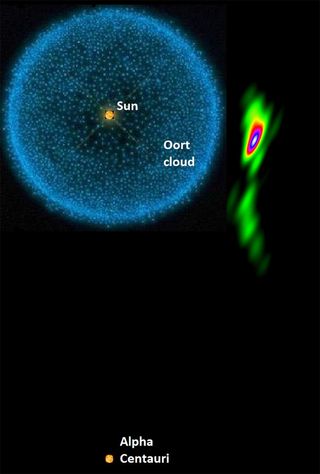Amazing! See the 'Most Detailed Astronomy Image' Ever Taken

A collection of 16 telescopes worked together to capture the highest-resolution astronomical image ever taken, comparable to spotting a 50-cent piece on the moon while standing on the Earth, according to a statement from the National Radio Astronomy Observatory (NRAO).
The new image doesn't look like the high-res view on a brand-new flat-screen TV. In fact, it looks a lot like a blurry smudge of light. But consider that the object in the picture is a black hole in a galaxy 900 million light-years from Earth.
To capture the image, astronomers combined Russia's orbiting radio satellite Spektr-R with 15 ground-based radio telescopes, including the National Science Foundation's Very Long Baseline Array. The resolution of a telescope depends greatly on its size, and combining multiple telescopes can have the same effect as building a single, massive instrument. In this case, combining Spektr-R with the 15 ground telescopes created an enormous instrument, comparable to a 63,000-mile-wide (100,000 kilometers) radio telescope, according to a statement from NRAO. A single telescope of this size would be eight times the diameter of the Earth. The project is led by the Astro Space Center in Moscow.

The image shows a jet of material being spewed into space by the monster black hole that lies at the center of the galaxy BL Lacertae. Like most black holes its size, the object gorges on material that swirls around the center of the galaxy. Not all of the material drawn toward the black hole is consumed, however. Some of the particles are accelerated to nearly the speed of light and then ejected, producing an enormous jet of material.
The jet in the image would fit within the outer boundary of Earth's solar system, marked by the Oort cloud, a sphere of icy, rocky objects that begins about 460 billion miles (740 billion km) from the sun.
The research appears in The Astrophysical Journal.
Follow Nola Taylor Redd on Twitter @NolaTRedd or Google+. Follow us at @Spacedotcom, Facebook or Google+. Originally published on Space.com.
Get the Space.com Newsletter
Breaking space news, the latest updates on rocket launches, skywatching events and more!
Join our Space Forums to keep talking space on the latest missions, night sky and more! And if you have a news tip, correction or comment, let us know at: community@space.com.

Nola Taylor Tillman is a contributing writer for Space.com. She loves all things space and astronomy-related, and enjoys the opportunity to learn more. She has a Bachelor’s degree in English and Astrophysics from Agnes Scott college and served as an intern at Sky & Telescope magazine. In her free time, she homeschools her four children. Follow her on Twitter at @NolaTRedd
